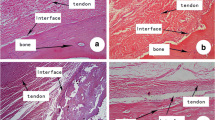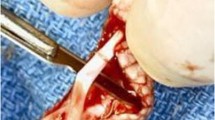Abstract
Purpose
Although most in vitro studies indicate that collagen is a suitable biomaterial for tendon and ligament tissue engineering, in vivo studies of implanted collagen for regeneration of these tissues are still lacking. The objectives of this study were the following: (1) to investigate the regeneration of the central third of the ovine patellar tendon using implants made of an open array of collagen fibres (reconstituted, extruded bovine collagen); and (2) to compare two collagen crosslinking chemistries: carbodiimide and carbodiimide associated with ethyleneglycoldiglycidylether.
Methods
Forty-eight Welsh Mountain sheep were operated on their right hind leg. The central third of patellar tendon was removed and substituted with carbodiimide (n = 16) and carbodiimide–ethyleneglycoldiglycidylether-crosslinked implants (n = 16). In the control group the defect was left empty (n = 16). The central third of contralateral unoperated tendons was used as positive controls. Half of the sheep in each group were killed at 3- and 6-month time points. After proper dissection, tendon sub-units (medial, central and lateral) were tested to failure (n = 6 for each group), whilst 2 non-dissected samples were used for histology.
Results
Both the implants had significantly lower stress to failure and modulus with respect to native tendon at both 3- and at 6-month time points. The implants did not statistically differ in stress to failure, whilst carbodiimide-crosslinked implants had significantly higher modulus than carbodiimide–ethyleneglycoldiglycidylether-crosslinked implants both at 3 and at 6 months. Histology showed carbodiimide-crosslinked implants to have a better integration with the native tendon than carbodiimide–ethyleneglycoldiglycidylether-crosslinked implants. Carbodiimide-crosslinked implants appeared partially resorbed and showed increased tissue ingrowth with respect to carbodiimide–ethyleneglycoldiglycidylether-crosslinked implants.
Conclusions
To deliver collagen implants as an open array of fibres allows optimal tendon–implant integration and good ingrowth of regenerated tissue. In the present study the resorption rate of both the examined implants was too low due to the high level of crosslinking. This led to only minor substitution of the implant with regenerated tissue, which in turn produced a low-strength implanted region. Further studies are needed to find the right balance between strength and resorption rate of collagen fibres.





Similar content being viewed by others
References
Aurora A, McCarron J, Iannotti JP, Derwin K (2007) Commercially available extracellular matrix materials for rotator cuff repairs: state of the art and future trends. J Should Elbow Surg 16:S171–S178
Brooks P (2009) Extensor mechanism ruptures. Orthopedics 32:9–18
Cao Y, Liu Y, Liu W, Shan Q, Buonocore SD, Cui L (2002) Bridging tendon defects using autologous tenocyte engineered tendon in a hen model. Plast Reconstr Surg 110:1280–1289
Caruso AB, Dunn MG (2004) Functional evaluation of collagen fiber scaffolds for ACL reconstruction: cyclic loading in proteolytic enzyme solutions. J Biomed Mater Res, Part A 69A:164–171
Cavallaro JF, Kemp PD, Kraus KH (1994) Collagen fabrics as biomaterials. Biotechnol Bioeng 44:146–152
Chen J, Xu J, Wang A, Zheng M (2009) Scaffolds for tendon and ligament repair: review of the efficacy of commercial products. Expert Rev Med Devices 6:61–73
Chvapil M, Speer DP, Holubec H, Chvapil TA, King DH (1993) Collagen-fibers as a temporary scaffold for replacement of acl in goats. J Biomed Mater Res 27:313–325
Cornwell KG, Lei P, Andreadis ST, Pins GD (2007) Crosslinking of discrete self-assembled collagen threads: effects on mechanical strength and cell-matrix interactions. J Biomed Mater Res A 80A:362–371
Dunn MG, Tria AJ, Kato YP, Bechler JR, Ochner RS, Zawadsky JP, Silver FH (1992) Anterior cruciate ligament reconstruction using a composite collagenous prosthesis—a biomechanical and histologic-study in rabbits. Am J Sports Med 20:507–515
Enea D, Henson F, Kew S, Wardale J, Getgood A, Brooks R, Rushton N (2011) Extruded collagen fibres for tissue engineering applications: effect of crosslinking method on mechanical and biological properties. J Mater Sci Mater Med 22:1569–1578
Fan H, Liu H, Toh SL, Goh JC (2009) Anterior cruciate ligament regeneration using mesenchymal stem cells and silk scaffold in large animal model. Biomaterials 30:4967–4977
Gigante A, Cesari E, Busilacchi A, Manzotti S, Kyriakidou K, Greco F, Di Primio R, Mattioli-Belmonte M (2009) Collagen I membranes for tendon repair: effect of collagen fiber orientation on cell behavior. J Orthop Res 27:826–832
Goldstein JD, Tria AJ, Zawadsky JP, Kato YP, Christiansen D, Silver FH (1989) Development of a reconstituted collagen tendon prosthesis. A preliminary implantation study. J Bone Jt Surg Am 71:1183–1191
Jackson DW, Grood ES, Goldstein JD, Rosen MA, Kurzweil PR, Cummings JF, Simon TM (1993) A comparison of patellar tendon autograft and allograft used for anterior cruciate ligament reconstruction in the goat model. Am J Sports Med 21:176–185
Kato YP, Dunn MG, Zawadsky JP, Tria AJ, Silver FH (1991) Regeneration of Achilles-tendon with a collagen tendon prosthesis—results of a one-year implantation study. J Bone Jt Surg Am 73A:561–574
Kew SJ, Gwynne JH, Enea D, Abu-Rub M, Pandit A, Zeugolis D, Brooks RA, Rushton N, Best SM, Cameron RE (2011) Regeneration and repair of tendon and ligament tissue using collagen fibre biomaterials. Acta Biomater 7:3237–3247
LaPrade RF, Hamilton CD, Montgomery RD, Wentorf F, Hawkins HD (1997) The reharvested central third of the patellar tendon. A histologic and biomechanical analysis. Am J Sports Med 25:779–785
Legnani C, Ventura A, Terzaghi C, Borgo E, Albisetti W (2010) Anterior cruciate ligament reconstruction with synthetic grafts. A review of literature. Int Orthop 34:465–471
Liu Y, Ramanath HS, Wang DA (2008) Tendon tissue engineering using scaffold enhancing strategies. Trends Biotechnol 26:201–209
Longo UG, Lamberti A, Rizzello G, Maffulli N, Denaro V (2011) Synthetic augmentation in massive rotator cuff tears. Med Sport Sci 57:168–177
Maffulli N, Ajis A, Longo UG, Denaro V (2007) Chronic rupture of tendo Achillis. Foot Ankle Clin 12:583–596
Miyashita H, Ochi M, Ikuta Y (1997) Histological and biomechanical observations of the rabbit patellar tendon after removal of its central one-third. Arch Orthop Trauma Surg 116:454–462
Montgomery SR, Petrigliano FA, Gamradt SC (2011) Biologic augmentation of rotator cuff repair. Curr Rev Musculoskelet Med 4:221–230
Nho SJ, Delos D, Yadav H, Pensak M, Romeo AA, Warren RF, MacGillivray JD (2010) Biomechanical and biologic augmentation for the treatment of massive rotator cuff tears. Am J Sports Med 38:619–629
Noyes FR, Grood ES (1976) The strength of the anterior cruciate ligament in humans and Rhesus monkeys. J Bone Jt Surg Am 58:1074–1082
Ouyang HW, Goh JC, Thambyah A, Teoh SH, Lee EH (2003) Knitted poly-lactide-co-glycolide scaffold loaded with bone marrow stromal cells in repair and regeneration of rabbit Achilles tendon. Tissue Eng 9:431–439
Reinhardt KR, Hetsroni I, Marx RG (2010) Graft selection for anterior cruciate ligament reconstruction: a level I systematic review comparing failure rates and functional outcomes. Orthop Clin North Am 41:249–262
Shelton WR, Treacy SH, Dukes AD, Bomboy AL (1998) Use of allografts in knee reconstruction: II. Surgical considerations. J Am Acad Orthop Surg 6:169–175
Spindler KP, Kuhn JE, Freedman KB, Matthews CE, Dittus RS, Harrell FE Jr (2004) Anterior cruciate ligament reconstruction autograft choice: bone-tendon-bone versus hamstring: does it really matter? A systematic review. Am J Sports Med 32:1986–1995
Tohyama H, Yasuda K, Kitamura Y, Yamamoto E, Hayashi K (2003) The changes in mechanical properties of regenerated and residual tissues in the patellar tendon after removal of its central portion. Clin Biomech (Bristol, Avon) 18:765–772
Ventura A, Terzaghi C, Legnani C, Borgo E, Albisetti W (2010) Synthetic grafts for anterior cruciate ligament rupture: 19-year outcome study. Knee 17:108–113
Weadock KS, Miller EJ, Keuffel EL, Dunn MG (1996) Effect of physical crosslinking methods on collagen-fiber durability in proteolytic solutions. J Biomed Mater Res 32:221–226
Zeeman R, Dijkstra PJ, van Wachem PB, van Luyn MJ, Hendriks M, Cahalan PT, Feijen J (1999) Successive epoxy and carbodiimide cross-linking of dermal sheep collagen. Biomaterials 20:921–931
Zeugolis DI, Paul GR, Attenburrow G (2009) Cross-linking of extruded collagen fibers-a biomimetic three-dimensional scaffold for tissue engineering applications. J Biomed Mater Res A 89A:895–908
Acknowledgments
The authors gratefully acknowledge the founding support of the Technology Strategy Board (grant number DT/F006977/1) and of the National Institute for Health Research. The authors would like to thank Dr. Andrew Rayment for his help with mechanical testing, Dr. Ben Ting Yiu Wong for his help with the surgery and Dr. Jeremy Skepper for his help with the histology sample preparation. Dr D. Enea gratefully acknowledges Prof F. Greco and Dr A. Gigante (Clinica Ortopedica, Polytechnic University of Marche) for their helpfulness and support.
Author information
Authors and Affiliations
Corresponding author
Rights and permissions
About this article
Cite this article
Enea, D., Gwynne, J., Kew, S. et al. Collagen fibre implant for tendon and ligament biological augmentation. In vivo study in an ovine model. Knee Surg Sports Traumatol Arthrosc 21, 1783–1793 (2013). https://doi.org/10.1007/s00167-012-2102-7
Received:
Accepted:
Published:
Issue Date:
DOI: https://doi.org/10.1007/s00167-012-2102-7




